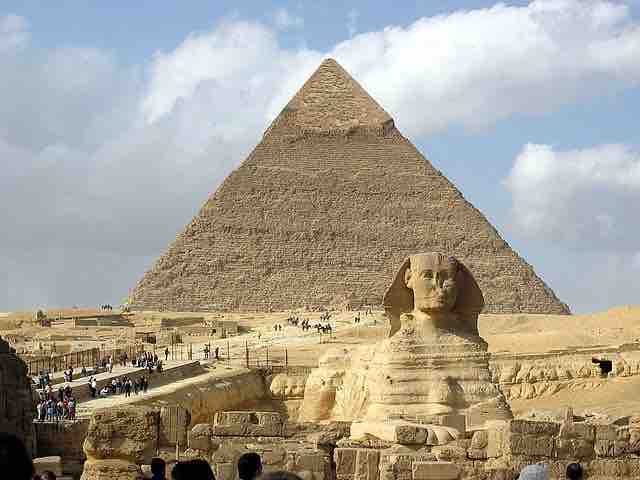The Old Kingdom is the name commonly given to the period from the Third Dynasty through the Sixth Dynasty (2686-2181 BCE), when Egypt gained in complexity and achievement. The Old Kingdom is the first of three so-called "Kingdom" periods that mark the high points of civilization in the Nile Valley. During this time, a new type of pyramid (the step) was created, as well as many other massive building projects, including the Sphinx. Additionally, trade became more widespread, new religious ideas were born, and the strong centralized government was subtly weakened and finally collapsed.
The king (not yet called Pharaoh) of Egypt during this period resided in the new royal capital, Memphis. He was considered a living god, and was believed to ensure the annual flooding of the Nile. This flooding was necessary for crop growth. The Old Kingdom is perhaps best known for a large number of pyramids, which were constructed as royal burial places. Thus, the period of the Old Kingdom is often called "The Age of the Pyramids."
Egypt's Old Kingdom was also a dynamic period in the development of Egyptian art. Sculptors created early portraits, the first life-size statues, and perfected the art of carving intricate relief decoration. These had two principal functions: to ensure an ordered existence, and to defeat death by preserving life in the next world.
The Beginning: Third Dynasty (c. 2650-2613 BCE)
The first notable king of the Old Kingdom was Djoser (reigned from 2691-2625 BCE) of the Third Dynasty, who ordered the construction of the step pyramid in Memphis' necropolis, Saqqara. It was in this era that formerly independent ancient Egyptian states became known as nomes, and were ruled solely by the king. The former rulers of these states were forced to assume the role of governors or tax collectors.
Golden Age: Fourth Dynasty (2613-2494 BCE)
The Old Kingdom and its royal power reached a zenith under the Fourth Dynasty, which began with Sneferu (2613-2589 BCE). Using a greater mass of stones than any other king, he built three pyramids: Meidum, the Bent Pyramid, and the Red Pyramid. He also sent his military into Sinai, Nubia and Libya, and began to trade with Lebanon for cedar.
Sneferu was succeeded by his (in)famous son, Khufu (2589-2566 BCE), who built the Great Pyramid of Giza. After Khufu's death, one of his sons built the second pyramid, and the Sphinx in Giza. Creating these massive projects required a centralized government with strong powers, sophistication and prosperity. Builders of the pyramids were not slaves but peasants, working in the farming off-season, along with specialists like stone cutters, mathematicians, and priests. Each household needed to provide a worker for these projects, although the wealthy could have a substitute.
The Pyramid of Khufu at Giza
The Great Pyramid of Giza was built c. 2560 BCE, by Khufu during the Fourth Dynasty. It was built as a tomb for Khufu and constructed over a 20-year period. Modern estimates place construction efforts to require an average workforce of 14,567 people and a peak workforce of 40,000.
The Great Sphinx of Giza

Great Sphinx of Giza and the pyramid of Khafre
The Sphinx is a limestone statue of a reclining mythical creature with a lion's body and a human head that stands on the Giza Plateau on the west bank of the Nile in Giza, Egypt. The face is generally believed to represent the face of King Khafra.
The later kings of the Fourth Dynasty were king Menkaura (2532-2504 BCE), who built the smallest pyramid in Giza, Shepseskaf (2504-2498 BCE), and perhaps Djedefptah (2498-2496 BCE). During this period, there were military expeditions into Canaan and Nubia, spreading Egyptian influence along the Nile into modern-day Sudan.
Religious Changes: Fifth Dynasty (2494-2345 BCE)
The Fifth Dynasty began with Userkaf (2494-2487 BCE), and with several religious changes. The cult of the sun god Ra, and temples built for him, began to grow in importance during the Fifth Dynasty. This lessened efforts to build pyramids. Funerary prayers on royal tombs (called Pyramid Texts) appeared, and the cult of the deity Osiris ascended in importance.
Egyptians began to build ships to trade across maritime routes. Goods included ebony, incense, gold, and copper. They traded with Lebanon for cedar, and perhaps with modern-day Somalia for other goods. Ships were held together by tightly tied ropes.
Decline and Collapse: The Sixth Dynasty (2345-2181 BCE)
The power of the king and central government declined during this period, while that of nomarchs (regional governors) increased. These nomarchs were not part of the royal family. They passed down the title through their lineage, thus creating local dynasties that were not under the control of the king. Internal disorder resulted during and after the long reign of Pepi II (2278-2184 BCE), due to succession struggles, and eventually led to civil war. The final blow was a severe drought between 2200-2150 BCE, which prevented Nile flooding. Famine, conflict, and collapse beset the Old Kingdom for decades.